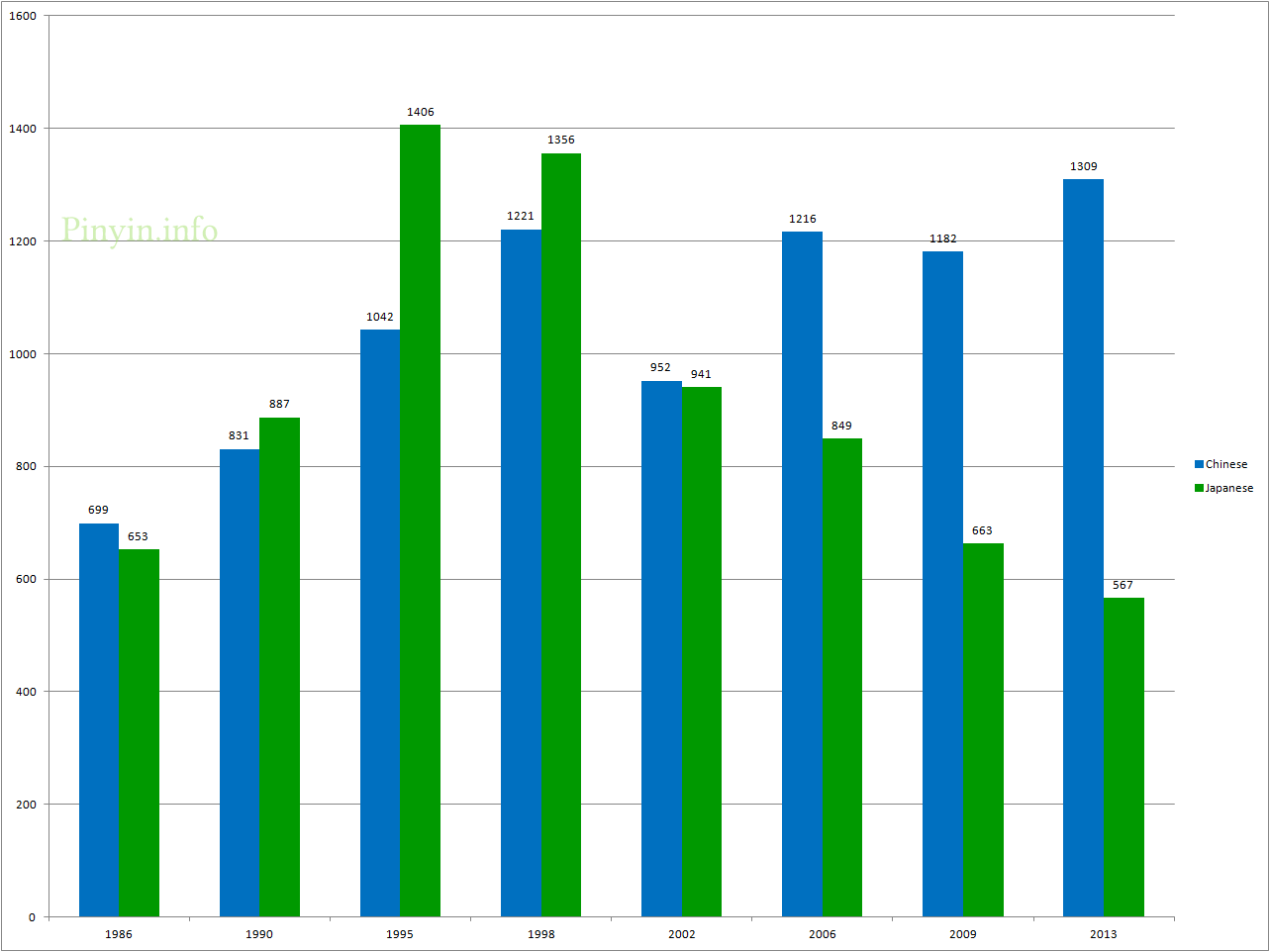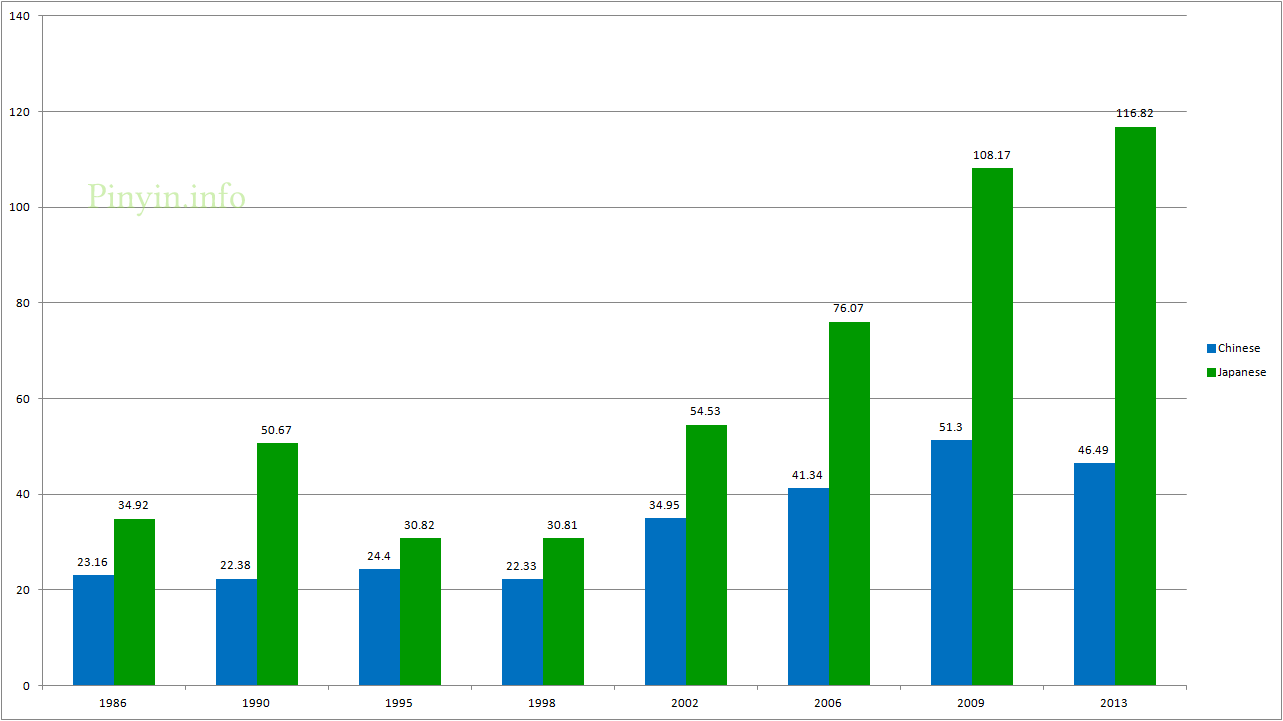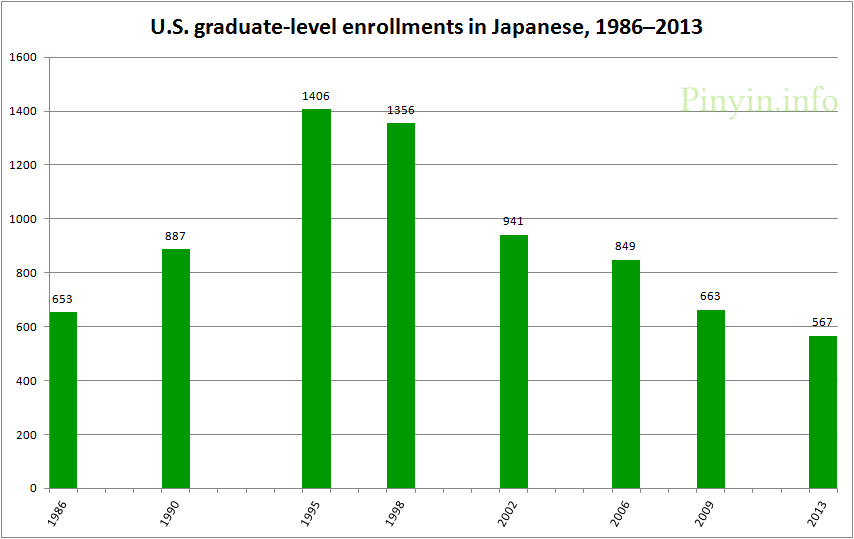Fewer and fewer people are taking graduate-level Japanese classes in U.S. universities, according to data recently released by the MLA.
Graduate-level enrollments in Japanese classes are at their lowest level since 1983 and have declined to less than half of their peak level, which was reached in 1995.
Here are a few more years. When looking at the earlier peaks, it’s worth remember that there are a lot more people in graduate school now than there were several decades ago, both in absolute terms and as a percentage of the population. So the recent figures are even more bleak than they might appear at first glance.
U.S. graduate-level enrollments in Japanese, 1960–2013

You might be wondering how Japanese stacks up against another Asian language. Here’s a comparison with graduate enrollments in Chinese (in blue). Again, the situation isn’t looking good for Japanese.
Graduate enrollments in Japanese vs. graduate enrollments in Chinese, 1986–2013

And here’s a look at the number of undergraduate enrollments in Japanese (green) and Chinese (blue) per enrollment in a graduate course in the same respective language.
Number of undergraduate enrollments in Japanese and Chinese per enrollment in a graduate course for the same language

Even so, boosters of Japanese may take heart that there are still more post-secondary enrollments in Japanese than in Mandarin. But more on that in a later post.
(For those of you who are wondering, no, this blog isn’t really back just yet. But I think these numbers are interesting. Also, my MLA-related posts don’t need Hanzi or Pinyin diacritics, which would only get messed up anyway. Thus, I might as well post the information for others to see.)


Surprised to see a new post in my RSS feed today. I do miss this blog. I saw the character encodings were messed up following the hack, and the comment you posted on the WordPress forum about it at the time. I’m more than happy to help if you want a hand – I’m familiar with WordPress and have experience of converting text between encodings. (I think the “Swedish” is a red herring; you possibly need to run the database backup through a conversion utility before importing it.)
The encoding problem might be caused by a missing or wrong DB_CHARSET definition in wp-config.php. Somewhere there should be either
define(‘DB_CHARSET’, ‘latin1’);
or
define(‘DB_CHARSET’, ‘utf8’);
On my blog, if I change it from the latin1 to utf8, I see the same problem that you’re having (why that is the case is beyond me).
I just double checked. The config file is already set at “define(‘DB_CHARSET’, ‘utf8’);”
The utility I use on Linux is iconv. I have just used your example of Zhou Youguang’s Chinese name turning into the nonsense starting with a lower case a-ring symbol. Out of 1174 supported character sets, only 11 produce this result, namely:
CP1004
CP1252
CP1254
CP1258
IBM1004
MS-ANSI
MS-TURK
OS2LATIN1
WINDOWS-1252
WINDOWS-1254
WINDOWS-1258
If I run (for example):
iconv -f UTF8 -t MS-ANSI text.txt
where text.txt contains the nonsense, it produces the correct Chinese characters.
I’m trying to think what this means. I’m sure the original text wasn’t in one of those character sets. Most likely it was UTF8 to start with. But for some reason, the method you used to import the database wrongly assumed the input to be in one of those character sets, and applied a conversion to UTF8, making it sort of doubly UTF8’d, if you see what I mean.
So how to correct things? I would be tempted to try dumping the database and running it through iconv as above, then re-importing it, making sure it imports it as UTF8 (obviously retaining a backup of the original dump in case it goes wrong!). Even better would be if you have an offline server on your PC that you can test it on before applying it to the live version.
There may also be a way to correct it by running some sort of MySQL query, but it’s hard without knowing the setup of the server.
I may play about with my offline server tomorrow, to see if I can reproduce your original problem, but it’s late in the UK now (plus it’s the change to summer time so I lose an hour’s sleep!)
Yes, surprised to see a new post in my RSS feed today, too.
I’ve tried working with a database dump, but it lead me to realise that other “special” characters such as left/right quotes appear correctly on your blog. I’m surprised they aren’t messed up in the same way. It’s hard to know what happened without knowing how you restored the site following the hack. But in your situation, assuming no automated method worked, I would probably resort to running the database through iconv, then running an interactive diff session (such as Emacs’s “Ediff”) and manually choosing which of the changes to accept. Slightly painful, but you only need to do it once, then re-import the database. You could run search and replace on common characters such as quotes and apostrophes first.
Another option is to look at re-importing your original backup from 2012, adding content (mainly comments) since then to the SQL dump before re-importing it. It shouldn’t be too tricky, given that WordPress numbers everything sequentially.
I use this plugin to backup the database:
https://wordpress.org/plugins/wp-db-backup/
Works with the latest WordPress, despite what it says.
Out of interest, what happens if I type ??? in a new comment? Is it still messed up?
Thank you so much, Jonathan, for the work you’re contributing. I know we are but a few of many who would be very, very happy to see this blog reinstated to its full glory.
Wow! It is wonderful to see that you have returned to writing here.
I missed this blog immensely shortly after you stopped posting three years ago — a seemingly sudden and unannounced departure. I continued to check this site for new posts on a monthly basis until late 2013. Unlike some of the other readers, I don’t have an RSS feed, so I’ve only just now noticed that you are back.
On the other hand, time sure does fly. It seems like only yesterday that I was visiting pinyin.info on a weekly basis to check for new posts…
It’s good to have you back!
It get a bit worse for Japanese language. It’s not Chinese language that seen an increase, but the Korean language has also seen a big leap in enrollment in US College/Universities.
http://www.voanews.com/a/enrollment-in-korean-language-classes-growing/2731075.html
http://www.latimes.com/local/education/la-me-korean-language-20150401-story.html
http://keia.org/korean-boom-foreign-language-enrollments-drop-us-korean-rise
And you can thank K-pop and K-drama for that. I mean anime and manga are popular right, why aren’t they making fans learning Japanese like K-pop and K-dramas are making fans learn Korean?